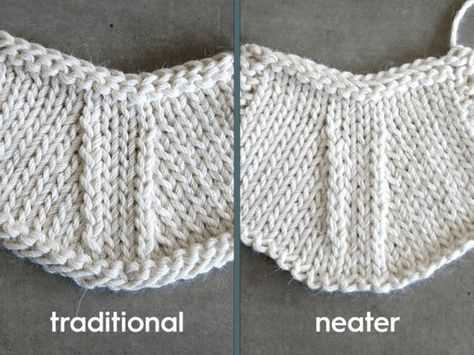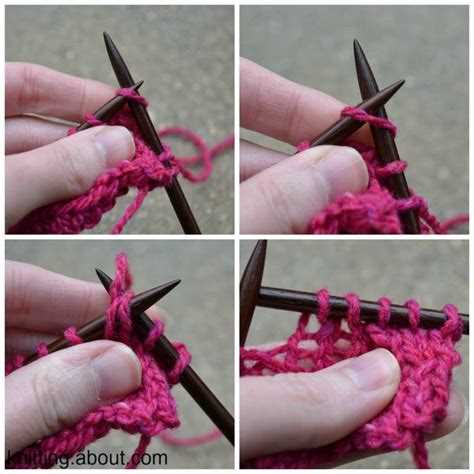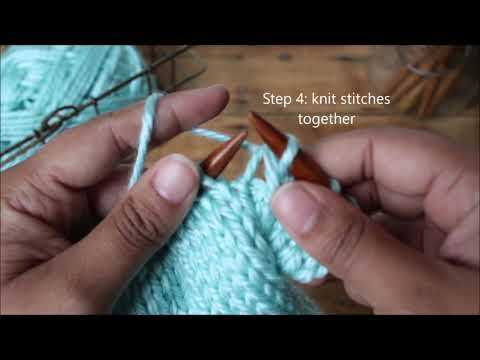Knitting is a craft that has been passed down through generations, and it comes with a unique language of its own. If you have recently taken up knitting, you may have come across the acronym SSK and wondered what it actually means. SSK stands for “Slip, Slip, Knit” and it is a technique used to decrease stitches in your knitting project.
The SSK stitch is commonly used in lace patterns, where a decrease is required to create a decorative motif. It involves slipping two stitches one by one from the left-hand needle to the right-hand needle, and then knitting them together through the back loop. This creates a left-leaning decrease that is often used to mirror a right-leaning decrease, such as the knit two together (K2tog) stitch.
Learning the SSK stitch is essential for beginner knitters as it opens up a world of possibilities in creating intricate patterns and designs. While it may seem daunting at first, with practice and patience, you will soon be able to incorporate the SSK stitch seamlessly into your knitting projects.
How SSK Differs from Other Knitting Stitches
When learning to knit, it’s important to understand how each stitch and technique differs from others. The slip slip knit (SSK) stitch is no exception. Here are a few ways that the SSK stitch differs from other common knitting stitches:
- Direction of Decrease: Unlike knit stitches which are worked from left to right, the SSK stitch is worked from right to left. This means that the resulting decrease slants to the left, creating a visually different effect.
- Stitch Placement: In an SSK stitch, two stitches are slipped individually from the left needle onto the right needle, making sure to slip them as if to knit. The next step involves inserting the left-hand needle from left to right into the front loops of these slipped stitches and then knitting them together. This differs from other decrease stitches, such as the knit two together (K2tog), where the stitches are knit together without slipping them first.
- Appearance: The SSK stitch creates a left-leaning decrease that is often used in lace patterns to create a more decorative effect. This differs from other decrease stitches, such as the knit two together (K2tog), which creates a right-leaning decrease.
In summary, the SSK stitch is unique in its direction of decrease, stitch placement, and resulting appearance. Understanding these differences will help you master the SSK stitch and incorporate it effectively into your knitting projects.
The Importance of Proper SSK Technique
The SSK technique, short for Slip, Slip, Knit, is an important stitch in knitting that is used to decrease the number of stitches in a row and create various stitch patterns. It is important for beginners to learn the proper SSK technique because it can greatly impact the appearance and quality of their knitting projects.
Here are a few reasons why mastering the SSK technique is essential:
- Improves the aesthetics: When done correctly, the SSK stitch creates a nice, smooth, and even decrease that blends seamlessly with the surrounding stitches. This helps to maintain the overall appearance and symmetry of your knitting project.
- Prevents unraveling: Properly executed SSK stitches are less prone to unraveling compared to poorly executed ones. By slipping the stitches individually and knitting them together in the back loop, the stitch is secured and less likely to come undone.
- Enhances stitch patterns: Many stitch patterns, such as lace and cables, rely on correctly executed SSK decreases to create the desired texture and design. By mastering the SSK technique, you can fully appreciate and create intricate stitch patterns in your knitting projects.
- Facilitates shaping: The SSK technique is often used to shape various knitting projects, such as sleeves, necklines, and waistlines. By decreasing the number of stitches in a row, you can achieve the desired shaping and fit for your garment.
Remember, practice makes perfect when it comes to knitting techniques. Don’t be discouraged if you struggle with the SSK technique at first – keep practicing, watch tutorials, and seek guidance from experienced knitters. With time and patience, you will master this essential technique and be able to create beautiful, professional-looking knitting projects.
Common Mistakes to Avoid when Working with SSK
While SSK (slip slip knit) is a relatively simple technique in knitting, it’s easy to make mistakes, especially if you’re a beginner. Here are some common mistakes to avoid when working with SSK:
-
Twisting the Stitches: One of the most common mistakes is twisting the stitches when performing the SSK. Make sure to slip the stitches onto the right needle one at a time without twisting them. This will prevent your stitches from being twisted and ensure that your SSK looks neat and tidy.
-
Slipping the Stitches in the Wrong Direction: Another mistake is slipping the stitches in the wrong direction. When performing the SSK, you should slip the stitches purlwise, which means inserting the right needle from right to left into the first stitch on the left needle. Slipping the stitches in the wrong direction can result in a messy appearance and uneven tension.
-
Not Paying Attention to the Decrease: It’s important to pay attention to the SSK decrease and its effects on your knitting. Make sure to keep track of your stitch count and pattern instructions to avoid any mistakes or inconsistencies in your work.
-
Not Practicing the SSK: As with any new knitting technique, it’s important to practice the SSK before incorporating it into your project. Take the time to practice the SSK on a swatch or scrap yarn to familiarize yourself with the technique and to ensure that you’re comfortable with it before using it in your actual knitting.
Avoiding these common mistakes will help you achieve neat and professional-looking SSK decreases in your knitting. Remember to take your time, pay attention to the details, and practice until you feel confident in your skills.
Tips and Tricks for Mastering SSK
Learning the SSK stitch can take some practice, but with these tips and tricks, you’ll be a pro in no time!
- Practice with scrap yarn: Before starting a project that requires SSK, it’s a good idea to practice the stitch with scrap yarn. This will help you get a feel for the technique and make it easier to execute when it’s time to use it in your actual project.
- Hold the needles correctly: When performing an SSK, it’s important to hold the needles correctly. The left-hand needle should be in front of the right-hand needle, and the yarn should be in the back.
- Keep tension even: Maintaining even tension is crucial when working the SSK stitch. If your tension is too tight or too loose, it can affect the appearance of your work. Take your time and adjust your tension as needed.
- Watch your stitch orientation: Pay close attention to the orientation of your stitches when working an SSK. The left-hand stitch should be on top of the right-hand stitch. This will ensure that the decrease slants correctly.
- Use stitch markers: To keep track of your SSK decreases, you can use stitch markers. Place a marker on the right-hand side of the decrease to help you visually identify where it is in your work.
With these tips in mind, you’ll be well on your way to mastering the SSK stitch. Remember to practice and be patient with yourself as you learn. Happy knitting!
Understanding the Benefits of SSK in Knitting Projects
In knitting, the SSK (slip, slip, knit) technique is an important stitch decrease that can have several benefits for your knitting projects. Here are some of the main advantages of using the SSK technique:
- Improved aesthetics: When working on projects that require decreasing stitches, using the SSK technique can result in a more visually appealing finish. Unlike other decrease stitches, SSK slants to the left, mirroring the appearance of a knit stitch. This creates a seamless and polished look.
- Reduced bulkiness: In traditional decreases like the knit two together (k2tog) stitch, the decrease is created by knitting two stitches together. This can result in a bulkier and more noticeable decrease line. On the other hand, the SSK technique involves slipping two stitches individually before knitting them together, which creates a smoother and less bulky decrease.
- Easier stitch maneuverability: The SSK technique allows for easier stitch maneuverability, especially when working on intricate stitch patterns or lace projects. The slipped stitches in SSK are easier to work with compared to other decrease stitches, allowing you to maintain stitch integrity and avoid potential mistakes.
- Symmetry: Using SSK alongside other stitch techniques can help create symmetry in your knitting projects. Since SSK slants to the left, pairing it with another decrease stitch that slants to the right can create a more balanced and aesthetically pleasing design.
- Versatility: The SSK technique can be used in a variety of knitting projects, from simple scarves to complex sweaters. Once you master this technique, you can incorporate it into your knitting repertoire and experiment with different stitch patterns and designs.
Overall, understanding the benefits of SSK in knitting projects can enhance your knitting skills and help you achieve more professional-looking results. Whether you’re a beginner or an experienced knitter, incorporating the SSK technique into your projects can elevate your craftsmanship and create stunning finished pieces.
Incorporating SSK into Different Knitting Patterns
Once you have mastered the SSK decrease technique, you can incorporate it into various knitting patterns to add interesting textures and shapes to your projects. Here are some common knitting patterns where you can use the SSK:
- Lace patterns: SSK is often used in lace patterns to create the characteristic eyelet holes and intricate designs. It is commonly used to decrease two stitches in a row, creating a left-leaning decrease that complements the overall lace motif.
- Ribbing patterns: SSK can be used in ribbing patterns to create a more polished and uniform look. By decreasing two stitches in a row using SSK, the ribbing will flow smoothly and maintain a consistent pattern.
- Cabling patterns: SSK can be used in cabling patterns to create symmetrical decreases that match the twists and turns of the cables. It is often used in combination with other decrease techniques to maintain the cable pattern’s overall integrity.
- Decrease patterns: SSK is a versatile decrease technique that can be used in various decrease patterns. It can be used alongside other decrease techniques, such as K2tog or SKP, to create shaping and design elements in your knitting.
Remember, when incorporating SSK into different knitting patterns, it’s essential to follow the pattern instructions and charts carefully. Pay attention to the specific placement and frequency of SSK decreases to ensure that your finished project looks as intended.
Experimenting with SSK in different knitting patterns can be a fun way to enhance your knitting skills and create unique and beautiful projects. As you gain confidence in using this versatile decrease technique, you’ll be able to explore more complex patterns and designs.
Exploring Advanced Applications of SSK in Knitting
Once you have mastered the basic SSK (slip, slip, knit) stitch in knitting, you can start exploring its advanced applications. The SSK stitch is a useful technique that creates a left-leaning decrease by slipping two stitches knitwise, and then knitting them together through the back loops. This decrease stitch is often used to shape the fabric by reducing the number of stitches in a row.
Here are some advanced applications of the SSK stitch:
- Decreasing in Lace Patterns: The SSK stitch is commonly used in lace knitting to create a smooth and symmetrical decrease in the pattern. It blends seamlessly with the yarnovers and other lace stitches, creating a beautiful overall design.
- Cabling Techniques: The SSK stitch can be incorporated into cable knitting techniques to create more intricate and complex cable designs. By combining the SSK stitch with other cable stitches, you can achieve unique and visually appealing cable patterns.
- Shaping Garments: The SSK stitch is frequently used for shaping garments, such as sleeves, waistlines, and neckline decreases. Its left-leaning characteristic helps create a flattering fit and contour to the body.
- Reversible Stitch Patterns: When working on reversible stitch patterns, the SSK stitch can be used to maintain consistency on both sides of the fabric. It creates a neat and reversible decrease that is indistinguishable from either side.
It is important to note that while the basic technique of the SSK stitch remains the same, its application can vary depending on the knitting pattern and design. Some patterns may specify a different method or variation of the SSK stitch, so always refer to the pattern instructions for the best results.
Experimenting with the advanced applications of the SSK stitch can enhance your knitting skills and allow you to create more intricate and professional-looking projects. Take the time to practice and familiarize yourself with these techniques to expand your knitting repertoire.
FAQ:
What does SSK stand for in knitting?
SSK stands for Slip, Slip, Knit. It is a decrease stitch that is commonly used in knitting patterns.
How do I do the SSK stitch?
To do the SSK stitch, slip two stitches knitwise, one at a time, onto the right needle. Then, insert the left needle into the front loops of the slipped stitches and knit them together.
When should I use the SSK stitch?
The SSK stitch is often used when you want to decrease stitches and create a slanting decrease to the left. It is commonly used in shaping the neckline or armholes of a garment.
Can I substitute SSK with another decrease stitch?
Yes, you can substitute SSK with another decrease stitch called K2tog (Knit 2 Together). However, they create slightly different angles in the fabric, so make sure to follow the pattern instructions for the best result.


